Narcissistic Personality Disorder and Creative Art—The Case of Paul Gauguin
by
Ronnie Mather
May 20, 2007
The personal excesses of Paul Gauguin are relatively well-known. This paper argues that Gauguin was suffering from a disorder known as Narcissistic Personality Disorder and that this directly impacted his creative work, particularly in the later years. Gauguin's narcissism is readily apparent from both published biographies and from his own writings. But the nature and structure of his own narcissistic fantasies are also apparent in his art. These manifest themselves in some of his most famous works and constitute a defence against both anxiety and depression. Themes such as birth, death, the nature of the self are dealt with in a fashion typical of a narcissist prone to grandiose fantasies.
The following might be regarded as an excursus on the autonomy of the creative imagination. Or, perhaps, an "ideal type" (in the Weberian sense) of an argument, an extreme argument, in stating the opposite; that is, that the products of the creative process are, in certain specific instances, reducible to the psychological state of the individual that has produced it. The "psychologizing of art" is reckoned by some to be very bad form, even by those who are somewhat engaged in so doing. It has a distinguished philosophical pedigree emanating from Nietzsche continuing through Freudian psychoanalysis and continuing with recent psychological approaches to art, the psychology of perception and advances in neurobiology. It usually takes the form of a "guilty reductionism", a concomitant avowal and disavowal of artistic license. Sociological treatments of art, on the other hand, have less stringent superegos being granted freer license in interpreting artistic developments in light of social movements and the changing balance of social forces. They are also regarded as more academically respectable or at least fashionable and have informed all sorts of art commentary and critique. There are very eminent examples of both approaches to the work of Paul Gauguin. Most psychoanalytic readings of Gauguin focus on a "personality vainly struggling to fend off the consequences of the feminine identification he made as a fatherless child" (Gedo, 1983: 147), a position repeated by one of the most recent treatments of Gauguin (Collins, 2001: 43). Sociologically informed treatments of his work have often focused on issues of colonialism, racism and sexism (Pollock, 1992; Solomon-Godeau, 1989). There is merit in both approaches. The following offers a psychological treatment of Gauguin. Specifically, that Gauguin exhibited all the symptoms of what is now termed "Narcissistic Personality Disorder". Understanding of the latter in actual fact is informed by classical Freudianism, "self-psychology" (Kohut, 1971), psychology and psychiatry. Various reasons account for this fusion, and there are tensions as well as harmony within this marriage. The lexicon of narcissism is still overwhelmingly psychoanalytical, but developmental psychology is now very firmly of the opinion that the child is much more outwardly directed than had been previously supposed. Narcissistic investment in the ego, as a general stage of human development, the idea of an objectless undifferentiated phase, (in more philosophical terms, an identical subject-object), is at least questionable. This is problematic, not only for the classical Freudian account but also for the two most recent influential accounts of pathological narcissism (Kohut, 1971; Kernberg, 1975) that presuppose such a phase. As well as specific disagreements the whole notion of "personality disorder" itself sits uncomfortably with the classical Freudian account of neurotic symptomology. The shift from symptom to much broader "character analysis" by Wilhelm Reich and "personality" by Adler promises a general fixity of the self perhaps at odds with the changing balance of forces favored by Freud. Human beings, less and less, present themselves with symptoms reminiscent of the classical psychodynamic treatment (with the possible exception of OCD). For these, and numerous other reasons, the specific etiology of Narcissistic Personality Disorder is usually classified as unknown and its terms of reference drawn from a variety of sources whose broad parameters are described above. Individuals who present with this disorder express a pronounced, if rather poorly defined, dissatisfaction and disillusionment with life, often with a very sophisticated psychological vocabulary but whose emotional investment in others is minimal. Proponents of what Lasch (1979) termed a "culture of narcissism" and what the APA since 1980 has diagnosed as "Narcissistic Personality Disorder" (NPD). DSM IV TR (1994) lists the criteria for diagnosis as follows
Diagnostic Criteria for 301.81 Narcissistic Personality Disorder
A pervasive pattern of grandiosity (in fantasy or behavior), need for admiration, and lack of empathy, beginning by early adulthood and present in a variety of contexts, as indicated by five (or more) of the following:
(1) has a grandiose sense of self-importance
(2) is preoccupied with fantasies of unlimited success, power, brilliance, beauty, or ideal love
(3) believes that he or she is "special" and unique and can only be understood by, or should associate with, other special or high status people (or institutions)
(4) requires excessive admiration
(5) has a sense of entitlement, i.e., unreasonable expectations of especially favorable treatment or automatic compliance with his or her expectations
(6) is interpersonally exploitative, i.e., takes advantage of others to achieve his or her own ends
(7) lacks empathy: is unwilling to recognize or identify with the feelings and needs of others
(8) is often envious of others or believes that others are envious of him or her
(9) shows arrogant or haughty behaviours
As previously stated, the origin of the set of attitudes and behaviours described above is indeterminate at the moment and most practitioners adopt an attitude of eclectic agnosticism. But very few clinicians deny the existence of the disorder. The symptoms often overlap with other personality disorders including psychopathy. As anyone who has read even a selection of Gauguin’s biographers can testify it is easy to match Gauguin to all of the above behaviours and attitudes. All refer to his narcissistic rage and his violence against men and women. Gedo (1983: 139-40), describes him as "arrogantly overconfident", commenting on "his assurance that he possessed extraordinary powers" and his "sense of entitlement". Sweetman (1995) and others refers to his pronounced persecution complex and the fact that he would acknowledge no debt, material or artistic, to others. Nancy Mathews (2001) describes him throughout her work as a "fantasist", with claims concerning seduction and sporting achievements that are almost certainly outrageous lies. His sexual liaisons with a succession of 13 year olds in the process infecting them with syphilis is notorious. Add his lack of empathy, "completely unruffled by Vincent’s suicide" (Collins, 2001:220), then one is left to the only conclusion that "he demanded the homage due to a creator God" (Andersen, 1971: 10) and considered "that he was above, or at least outside, the rules that others conform to" (Mathews, ibid, 30). Against the charge of owing the dead a justification of the diagnosis of NPD the only conclusion possible is that it runs into several volumes at least. And not only Gauguin"s biographers but his own writings as well. Mathews references to Gauguin’s grandiose fantasies are particularly interesting in that some commentators actually seems to regard them as historical events. A personal favourite is Gauguin’s tale in Avant et apres of seducing an opera singer who was being courted by the son of the Czar while a seaman third class. This fantasy, and there are plenty more throughout his writings, maintains self-esteem when the praise due to such an individual is not forthcoming. There is very good reason to suppose that narcissists use such fantasies to ward off anxiety or depression. Similarly, the "mystery" of why Gauguin took up art in middle age is not difficult to dispel. If maintenance of self-esteem requires excessive admiration then middle age may be the perfect moment to move from somatic to cerebral narcissism especially in modern societies. Narcissists can suffer more than most from the ravages of time.
In actual fact Gauguin’s writings are even more convincing in regard to his narcissism in general and narcissistic fantasy in particular. This is true of Avant et apres and Noa Noa, (Gauguin’s autobiographical account of his life in Polynesia). It is striking that the former contains accounts of his sexual conquests but without any account of anything of either real emotional significance such as the death of his mother while at sea or even an account of some of the places he visited, especially for a man who prided himself on his visual memory. The tendency to existential grandiosity is apparent but Noa Noa is even more revealing. All of Gauguin’s biographers are especially fond of quoting his two observations on the sexual attractiveness of males and females. The following ostensibly describes a trip with a young male to collect some wood for a sculpture and forms the basis of his picture Man with an Axe—"His lithe animal body had graceful contours, he walked in front of me sexless [. . .] this perfect harmony with the nature that surrounded us. I had a sort of presentiment of a crime, the desire for the unknown, the awakening of evil—Then weariness of the male role [. . .] I drew close, without fear of laws, my temples throbbing (1985:25). This is usually quoted in support of Gauguin’s homoeroticism but this has tended to underplay the sexless nature of the young male. One can see his desire for incorporation into this sexless being, the fantasy of being undifferentiated, the fantasy of being omnipotent "without fear of laws". The "awakening of evil" is but the knowledge of inescapable self-divestment not only into gender roles but the sheer overcoming of that divestment in physicalist form.
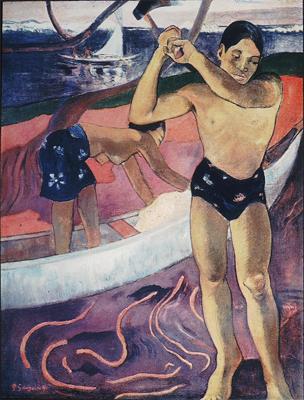
Private Collection, 1891
Gauguin recorded the above in his picture Man with an Axe but the whole temper of the piece is of fantasy rather than the narrative depiction of an event. But here is Gauguin speaking of the same desire in regard to women "I saw plenty of calm-eyed women. I wanted them to be taken without a word, brutally. In a way longing to rape" (1985: 28). Again, the fantasy of fusion, incorporation and a return to a primordial oneness. Most, if not all, of Noa Noa is an exercise in sheer fantasy regarding narcissistic aggression. And one can also see the linkage between narcissistic entitlement and rape that is being increasingly noted in the clinical literature (Champion, 2002; Bushman et al, 2003; Ryan, 2004). That return to primordial originality is what motivated Gauguin to go to Polynesia in the first place. Speaking in 1895 to a French journalist he stated "I was captivated by that virgin land and its primitive and simple race; I went back there, and I’m going to go back there again. In order to produce something new, you have to return to the original source, to the childhood of mankind".
Gauguin’s discourse, like Gauguin’s art, may have its roots in his personality rather than the prevailing social conditions of colonialism and sexism (and may account for the fact that he consciously held contradictory beliefs in this regard). Further evidence of this can be adduced from two sources, one personal, one artistic, but both ultimately similar. The first can be dealt with quite quickly and concerns Gauguin’s choice of marriage partner, Mette Gad. Here are two of Gauguin’s biographers attempting, albeit unsuccessfully, to understate their surprise at Gauguin’s choice. "Gauguin married a large Danish Viking whom even the staid French dictionary of national biography describes as masculine in appearance, and who in later life took to wearingly increasingly mannish clothing (Sweetman, 1995:4)—"What Gauguin saw in Mette is another question. One of her most outstanding traits was a mannishness in dress and character" (Collins, 2001:49). What Gauguin saw in her was precisely that androgynous character. Gauguin himself expressed it thus "If you want to be someone[. . .]you must consider yourself, like Androgyne, without sex" (Letter to Madeleine Bernard, 1888, in Eisenman, 116 ). Gauguin’s fascination with androgyny clearly exceeds an intellectual or even aesthetic predilection. The link between androgyny and narcissism is often assumed but has never been really clarified. Given the above, it may be symptomatic of some form of arrested development, the individual can be a male-female omnipotent God before the onset of somatic and social reality is rendered apparent by environmental constraints. But the linkage between the two though noted remains uncertain and generally functions as perhaps the undifferentiated ego-ideal or double the individual’s physiological and social development renders fantastic. A great example in Gauguin’s own art is the painting, The Lovers of 1902
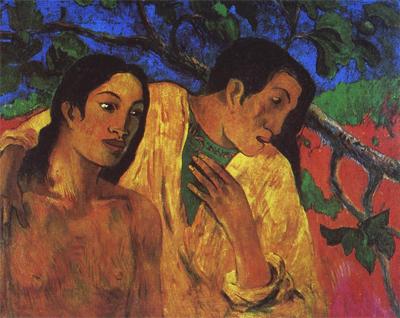
Narodni Gallery, Prague, 1902
John Gedo (1994: 81) is of the opinion that the naked lover is male but it is probably closer to the truth to state that Gauguin is representing the androgynous idealized double of a figure that is distinctly unattractive. The mammary configuration, cheekbones and hair rendering the figure deliciously ambiguous. Whatever the ultimate truth of the link between androgyny and narcissism (and the often imputed intervening variable of same-sex desire) it is unquestionably the central motif in Gauguin’s later work. That is, as part of Gauguin’s entire cycle of narcissistic fantasy, that shows how the androgyne came to be, its birth, its rebirth, in a geographically specified Garden of Eden.
Andersen’s (1971) treatment, despite its age, must still be reckoned the doyen of psychoanalytically informed Gauguin commentaries. He attempts to view Gauguin from a duality of vantage points. Firstly, as a Rousseauian protest against the ubiquitous corrupting forces of "civilization". Gauguin would recreate nature at Pont-Aven, Arles and Tahiti. The early Gauguin is presented as a man with both a sense and control of his own destiny, abandoning his family with that sense of destiny as his only solace. But not quite, for "nature" had bestowed a wondrous congruity, "always, his imaginative faculty grew commensurate with his technical proficiency" (1971: 129). Always.—"Gauguin wore the symbolist movement like a tattoo which marked the surface but never penetrated the flesh" (1971:139). But, at a certain point, that improving technique unleashed latent instincts and passions, a transformation located in the period 1880-86. "At such times he was not able to sustain a discreet aesthetic distance: the neutrality of the impressionists, the solidity of Cezanne, the restraints of an intellectual process such as neo-impressionism—all fell below the armed cavalry of his fuming instincts" (1971: 32). This is Andersen’s second (Freudian) vantage point. It is there that Gauguin’s genius and good fortune lie, the ability to immediately transform universal and timeless human emotion into art. A real royal road to and from the unconscious. A talent that is indeed almost the opposite of symbolism etc in the sense of retaining any vestige of intellectualism, Andersen reaching for the oxymoron "translated immediacy" (1971: 129) to describe this process. It is then onto Tahiti where that imagination and technique would replay the Gauguin family drama. Andersen interprets many of the paintings reproduced below. Gauguin would produce an idealized mother (Mary and Eve); the father he had never known (Christ); a primal dream of family unity, an obsession with androgyny reflecting a rapturous state prior to the loss of a parent. Nevertheless, an autonomous masculine identity must be won, Gauguin himself being represented in "Man with an Axe’ (see above) attacking Eve and the Garden of Eden. Or at least the corrupted ‘civilized" version thereof. This attack symbolizes Gauguin’s own rebirth or reconciliation with himself as both aesthete and "savage", an end to the Rousseauian polarity previously identified. He could be both, a "spiritual Androgyne" (1971: 205). Andersen never really explains why this is unsuccessful or brought Gauguin so little relief save for comments like "He shared the classic obsession of men who lose their fathers when very young: lacking a model [. . .] he consistently set himself trials of strength as if to prove[. . .]the fact of his own existence (1971: 224). The excesses of Gauguin’s behavior especially with regard to his young female companions and others are placed firmly at the door of this attempted overcoming of this over-identification with the mother. But it could not be overcome—"He drew his strength from the savagery of his mother—an essential fantasy for a fatherless boy" (1971: 262). But Andersen’s book never really specifies where Gauguin’s problems lay, the operations of the unconscious and "essential fantasy", or the vicissitude of being born European. Both diagnoses persist to the very end of this monumental and inspirational work. "His mother’s blood was his goal, but his patriarchal heritage was his daily burden" (1971: 263).
The structure of narcissistic fantasy was specified very early in the literature. Sheldon Bach (1977) gives it a fourfold structure
"the fantasy of the ‘wise baby’, which concerns the origin of the self’s uniqueness and perfection; the fantasy of the ‘death of the self’, which concerns our loss of perfection and our imprisonment within this world of limitations; the fantasy of the ‘double’, ‘companion’, or ‘anrdrogyne’, which concerns the origins of self love; and the fantasy of the ladder, tree or ‘rope to another world’, which concerns our search for transcendence of earthly limitations" (Bach 1997: 282)
The fourth fantasy, the rope to another world, is of course Polynesia itself, the background setting, where Gauguin travels to be reborn, the Garden of Eden, after the Golgotha of the spirit in France itself. The "death of the self" is never represented directly in the Tahitian paintings simply because that imprisonment and death occurs and is celebrated shortly before the first sojourn south. Gauguin’s misery at his imprisonment and limitation is celebrated in his portrayal of himself as Christ on the Mount of Olives (the "agony in the garden").

Norton Gallery and School of Art, Florida, 1889
The mood is one of profound depression rather than the physical agony described in the Bible, a case indeed of "the blues" with Paul carrying a great weight on his shoulders but having very little energy in his lifeless arms. A terrible fate for the artist who attracts little esteem. The tree portends the fate soon to befall the son of God, a fate painted in the same year and immortalized as Yellow Christ.
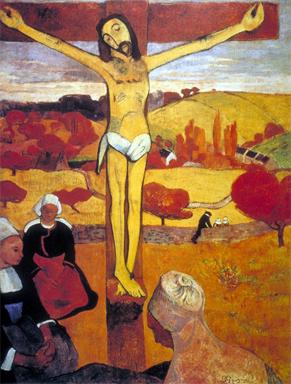
Albright-Knox Gallery, Buffalo, NY 1889
The people around the cross seem rather unperturbed if rather subdued and respectful at the fate of the saviour and yellow Christ seems in some sort of drooping torpor rather the victim of a brutal execution. Christ carries no discernible wounds, no crown of thorns. The choice of colour is rather vexing as well as the human eye is most sensitive to light in the yellow-green region of the spectrum and an extended viewing can be both fatiguing and irritating. The yellow Christ has died a narcissistic death. He demands attention but the death of the second person of the trinity symbolizes the crushing of the ego, its omnipotence, and the moment of origin of its need for veneration. The death of the self or at least part of it.
Its spirit heads south to the Pacific, where it is reborn. And this brings us to the first narcissistic fantasy identified by Bach, the wise baby. We all know the wisest baby, the saviour himself Gauguin. And here is the moment of his birth or rebirth in Tahiti (Birth of Christ, Son of God)
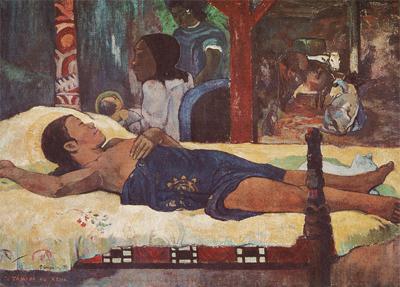
New Museum, Munich, Germany 1896
Here we see the rebirth of Gauguin with its typical allusions to the Nativity scene, the animals etc. are in the background. The fantasy of grandiose exceptionality is central to all narcissistic disorders. Gauguin has been ignored, ridiculed and indeed crucified in France. But one can clearly see his hopes for the future both in this and the following.
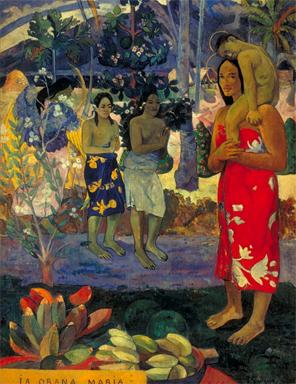
Metropolitan Museum of Art, NY 1891-92
One can see the obvious markers of divinity, the halos. One can also see the quite remarkable fusion of nature and divinity that Gauguin brings to this picture. Mary is unquestionably Gauguin’s mother as comparison to his own paintings of her will testify. It is here that Gauguin’s fantasies of omnipotence can be realized, a fact that others who had dealings with him in Tahiti soon came to realize. It is also the reason why a number of his schemes appear so ludicrous to his biographers, narcissists failing to distinguish between the highly improbable and impossible. Gauguin refused to give up any of his grandiose fantasies except towards the very end of his life. However, a not insubstantial difficulty encountered by all narcissists is that in asserting any identity whatsoever they inevitably lose at least part of the fantasy of omnipotence itself. These discarded parts of the omnipotent self often turn up as "spirits" in the Tahitian works (most notably in the famous Spirit of the Dead Watching). And as fantasies of achievement in Gauguin’s own biographies. His best and most challenging work is indicative of pronounced existential states rather than events which tend to be of secondary importance, as Bach states "The primitive Narcissistic fantasy is a non-event, centred on ‘I am’ rather than ‘I do’. (Bach 1977: 291). All of this culminates of course in Gauguin’s famous masterpiece, Where Do we Come From, What are We, Where are we Going?, which is reproduced below. The painting is riven in two by the androgynous Eve reaching for the apple
![Gauguin's WHERE DO WE COME FROM [. . .]..?](/Content/ArticleImages/2007/mather7.jpg)
Museum of Fine Arts, Boston, 1897
But the whole cast is present. The wise baby to the right, the death of the self, by the two shadowy female figures who seem to represent as much a depiction of death as a good narcissist might endure. The rope to another world is of course Tahiti itself shorn of course of all the western, syphilitic encroachments that Gauguin actually found there. Only a canvas of such a size captures, or could hope to capture, the narcissistic fantasy of a Gauguin, in reality that is Gauguin, his writing, his art, his life. And finally in this painting to the left he is capable of representing himself for what he is, a self-made, but ultimately Polynesian, God. He has become the master of his own household, the world he has created is to the foreground on the left hand side of the picture. The narcissistic fantasies to the right are the result, and are themselves initiated, by the androgynous Eve reaching for the apple, and in so doing destroying the paradise of omnipotence that Gauguin’s creator-God has made. It is not that humans are condemned to sin by eating from the tree of knowledge but that the curse of finitude and limitation that is social, political and gendered identity constitutes the origin of human suffering and narcissistic fantasy itself.
Clearly there are other works and artists that might admit of such a treatment. The narcissistic traits of an artist like Oscar Wilde are well-documented and The Picture of Dorian Gray must be reckoned a prime example of a narcissistic text. Similarly, a text like Frankenstein is as much about narcissism unbound as Prometheus not least in the figure of Victor Frankenstein himself (Berman, 1992). No general conclusions about the intrusion of psychological maladies into the process of artistic creation can be drawn from the above. Nevertheless, contra Gedo (1994: 106), Gauguin’s claim that all his work represented only himself must be taken seriously, not in the sense of having no artistic influences (a symptom of NPD in itself), but in the sense of externalizing the fantasies that acted as a defence against his own pathological narcissism.
Bibliogaphy
American Psychiatric Association (1994) DSM-IV-TR APA: Arlington VA
Andersen, W (1971) Gauguin’s Paradise Lost NY: Viking
Bach, S (1977) "On Narcissistic Fantasies" International Review of Psychonalysis vol.4 (281-93)
Berman, J (1992) Narcissism and the Novel NY: NY University Press
Brooks, P (1990) "Gauguins Tahitian Body" Yale Journal of Criticism 3,2 51-89
Bushman, B et al (2003) "Narcissism, Sexual Refusal, and Aggression: Testing a Narcissistic Reactance Model of Sexual Coercion" Journal of Personality and Social Psychology 84,5 1027-40
Champion, D (2002) Narcissism and Enitlement: Sexual Aggression and the College Male NY: LFB Publishing
Collins,B (2001) Electric Arguments and Utopian Dreams CO: Westview Press
Eisenman,S (1997) Gauguin’s Skirt NY: Thames & Hudson
Foster, H. (1993) "Primitive Scenes" Critical Inquiry vol.20 69-102
Gauguin, P (1994) Avant et aprčs Paris: Table ronde
Gauguin, P (1985) Noa Noa: Gauguin’s Tahiti ed. N.Wadley NH: Salem House
Gedo,J. (1994) "The Inner World of Paul Gauguin" Annual of Psychoanalysis vol.22 61-109
Gedo,J. (1983) Portraits of the Artist: Psychoanalysis of Creativity and its Vicissitudes NY: Guilford Press
Kernberg, O (1975) Borderline Conditions and Pathological Narcissism NY: Jason Aronson
Kohut, H (1971) The Analysis of the Self: A Systematic Approach to the Treatment of Narcissistic Personality Disorders NY: International Universities Press
Lasch, C (1979) The Culture of Narcissism NY: Norton
Mathews, N (2001) Paul Gauguin: An Erotic Life New Haven: Yale University Press
Pollock,G (1992) Avant-Garde Gambits, 1888-1893, Gender and the Colour of Art History London: Thames & Hudson
Ryan, K (2004) "Further Evidence for a Cognitive Component of Rape" >Aggression and Violent Behavior 9,6 579-604
Solomon-Godeau (1989) "Going Native" Art in America 77,7 120-38
Received: January 31, 2007, Published: May 20, 2007. Copyright © 2007 Ronnie Mather
